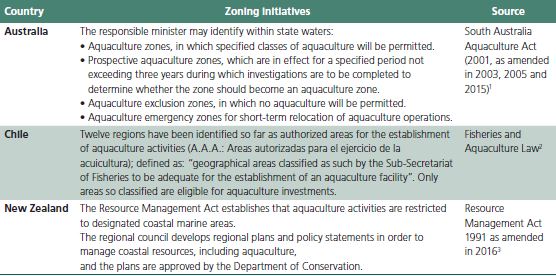4. ZONING
Zoning implies bringing together the criteria for locating aquaculture and other activities in order to define broad zones suitable for different activities or mixes of activities. Zoning is a process that countries can use to sustainably and responsibly identify and allocate areas that are biophysically and socio-economically suitable for aquaculture. In broad terms, zoning can be used to identify potential areas for growth where aquaculture is new, and help regulate the development of aquaculture where it is already established (Table 6).
Definition of the legal boundaries of zones demands a consultative process that aligns policy, law, local interests and ecological carrying capacity (more details on carrying capacity are found in Annex 4). More specifically, zoning according to GESAMP (2001) can be used to:
• prevent and control environmental deterioration at the farm and watershed scale;
• implement biosecurity measures and disaster risk management;
• reduce adverse social and environmental interactions; and
• serve as a focus for estimates of environmental capacity.
Additionally, zoning can also be used to:
• increase production and social development;
• serve as a platform for dialogue to reduce conflict among potential resource users;
• help potential developers identify prospective farm sites where long-term investments are possible (user rights);
• establish clear norms/regulations for commercial behaviour within zones; and
• define the area over which planners and regulators set and monitor objectives.
TABLE 6. Examples of zoning initiatives in different countries

1 South Australia Aquaculture Act. 2001. Consolidated version of Act No. 66 of 2001, as amended 1 July 2015, Australia (South Australia). FAOLEX No. LEX-FAOC044087. (also available at http://faolex.fao.org/docs/pdf/sa44087.pdf).
2 General Law on Fisheries and Aquaculture (No. 18.892). Ley General de Pesca y Acuicultura (Ley No. 18.892 de 1989). Texto refundido, coordinado y sistematizado ha sido fijado por el Decreto No. 430. Chile. FAOLEX No. LEX-FAOC001227. (also available at http://faolex.fao.org/docs/pdf/chi1227.pdf).
3 Resource Management Act. 1991. Act No. 69 of 1991. Reprint as at 18 October 2016, New Zealand. (also available at www.legislation.govt.nz/act/public/1991/0069/latest/DLM230265.html).
The zoning process is normally led by the government at the relevant geographical scale through a consultative interaction with national and local stakeholders, especially those who may invest or set up fish farms, and those who may be affected by aquaculture development (Hambrey et al., 2000).
Defining and agreeing on broad development objectives for an aquaculture zone is the focus for public involvement and participation. A range of rapid rural appraisal communication techniques are available and can be adapted to local circumstances to facilitate quality dialogue (see tools in Annex 4).
At the zoning stage, it is important to include policymakers and government planners; scientists (fishery, environment, rural sociology, economics) and farmer leaders; private industry representatives (supply inputs, traders, processors, exporters); and local authorities (agriculture, forestry, industry, tourism) where local development objectives and priorities are reviewed.
In some cases, the inclusion of non-governmental organizations (NGOs) and/or consumer groups might also be useful.
When the process of actual boundary definition, zone allocation and identification of possible impacts and mitigation strategies are discussed, it will be important to have representatives of local government; the fishery management agency; other local regulatory bodies (agriculture, forestry, industry, tourism); farmer groups; and relevant local communities, including indigenous groups. Depending upon the nature of the zone, valuable inputs from representatives of private industry, consumer groups and agribusiness associations might also be useful.
The key steps in the zoning process are:
(i) identification of areas suitable for aquaculture;
(ii) identification of issues and risks in zoning;
(iii) broad carrying capacity estimation for aquaculture zones;
(iv) biosecurity and zoning strategies; and
(v) legal designation of zones for aquaculture.